Practicing the CBSE Sample Papers for Class 10 Maths Standard Set 3 allows you to get rid of exam fear and be confident to appear for the exam.
CBSE Sample Papers for Class 10 Maths Standard Set 3 with Solutions
Section – A
Question 1.
For what least value of ‘ri natural number (24)n is divisible by 8?
(a) 1
(b) 2
(c) 3
(d) 4
Answer:
(a) 1
Explanation: Factors of (24)n = (8 x 3)n = 8n x 3n.
For least value of n, (24)n divisible by 8 is 1.
Question 2.
What is the product or sum of a rational and irrational numbers?
(a) Rational number
(b) Natural number
(c) Irrational number
(d) Integar number
Answer:
(c) Irrational number
Explanation: Product or sum of rational and irrational number will always be a irrational number.
eg.
\(2+\sqrt{3}\) is irrational number
\(5 \sqrt{7}\) is also a irrational number.
![]()
Question 3.
What is the ratio in which the line joining the points (6, 4) and (1, – 7) is divided by the X-axis?
(a) 5 : 4
(b) 4 : 7
(c) 7 : 4
(d) 4 : 5
Answer:
(b) 4 : 7
Explanation: Let, K : 1 be the ratio in which X-axis divides the line joining (6, 4) and (1, – 7).
Let, P be the point on X-axis that divides the line. Then
P (x,y) = \(\left[\frac{\mathrm{K}+6}{\mathrm{~K}+1}, \frac{-7 \mathrm{~K}+4}{\mathrm{~K}+1}\right]\)
As P (x,y) lies on X-axis P(x,o) = \(\left(\frac{K+6}{K+1}, \frac{-7 K+4}{K+1}\right)\) [? x-coordinate will be x, 0]
⇒ \(\frac{-7 K+4}{K+1}\) = 0
⇒ -7K + 4 = 0
⇒ 7K = 4
⇒ k = \(\frac { 4 }{ 7 }\)
So, the required ratio be K: 1 = \(\frac { 4 }{ 7 }\) : 1 = 4 : 7
Question 4.
What is a quadratic polynomial whose sum of zeroes is 3 and product of zeroes is – 2.
(a) x2 + 3x – 2
(b) x2 – 3x – 2
(c) x22 + 3x + 2
(d) x2 – 3x + 2
Answer:
(b) x2 – 3x – 2
Explanation: Given, sum of zeroes, S = 3
Product of zeroes, P = – 2
Required polynomial is given by
f(x) = x2 – (sum 0f zeroes)x + product of zeroes
⇒ f(x) = x2 – 3x – 2
Question 5.
If a, (a – 2) and 3a are in the arithmetic progression, then what is the value of a.
(a) – 2
(b) 2
(c) 1
(d) -1
Answer:
(a) – 2
Explanation: As, a, a – 2, 3a are AP.
Then, a – 2 – a =3a- (a-2)
⇒ – 2 – 2a + 2
⇒ 2a = – 2 – 2
⇒ 2a =- 4
⇒ a = – 2
Question 6.
For what value of k, the system equation 2x + 3y = 5 and 4x + ky = 10 has infinite solutions?
(a) 7
(b) 8
(c) 6
(d) 4
Answer:
(c) 6
Explanation: Given system of equation is
2x + 3y – 5 =0
4x + ky – 10 =0
Here, a1 = 2, b1 = 3, c3 = – 5
a2 = 4, b2 = k, c2 = -10
For infinite solutions,
\(\frac{a_1}{a_2}\) = \(\frac{b_1}{b_2}\) = \(\frac{c_1}{c_2}\)
⇒ \(\frac{2}{4}\) = \(\frac{3}{k}\) = \(\frac{5}{10}\)
⇒ \(\frac{2}{4}\) = \(\frac{3}{k}\)
2k = 3 × 4
k = 6
Hence, for k = 6 given system of equation has infinitely many solutions.
Question 7.
What is a natural number whose square diminished by 84 is thrice the 8 more of given number?
(a) 13
(b) 11
(c) 10
(d) 12
Answer:
(d) 12
Explanation: Let x be the natural number than according to question,
x2 – 84 = 3 (x + 8)
⇒ x2 – 84 = 3x + 24
⇒ x2 – 3x – 108 = 0
⇒ x2 – 12x + 9x – 108 = 0
⇒ x(x – 12) + 9(x – 12) =0
⇒ (x – 12) (x + 9) = 0
⇒ x – 12 = 0 or x + 9 = 0
⇒ x = 12 or x = -9
Since – 9 is not a natural number. So, the required number is 12.
Question 8.
What is the probability that a non-leap year selected at random will contain 53 Sundays?
(a) \(\frac { 1 }{ 7 }\)
(b) 7
(c) \(\frac { 1 }{ 6 }\)
(d) \(\frac { 6 }{ 7 }\)
Answer:
(a) \(\frac { 1 }{ 7 }\)
Explanation: A non-leap year has 365 days and so it has 52 weeks and 1 day.
This 1 day can be Sunday or Monday or Tuesday or Wednesday or Thursday or Fridays or Saturday. Thus, total outcomes = 7
Favourable outcome = 1
Probability = \(\frac { Number of favourable outcomes }{ Number of total outcomes }\) = \(\frac { 1 }{ 7 }\)
Question 9.
Σfi = 15, Σfixi = 3p +36 and Mean = 3
We know, Mean = \(\frac{\Sigma f_i x_i}{\Sigma f_i}\)
⇒ 3 = \(\frac{3 p+36}{15}\)
⇒ 45 = 3p + 36
⇒ 3p = 45 – 36
⇒ 3p = 9
∴ p = 3.
Question 10.
If P(E) = 0 .05, what is the probability of ‘not E’?
(a) 0.93
(b) 0.95
(c) 0.89
(d) 0.98
Answer:
(b) 0.95
Explanation:
Given: P(E) = 0.05
P(not E) =1 – 0.05 = 0.95
The propability of ‘not E’ is 0.95.
![]()
Question 11.
Two dice are thrown together. The probability of getting the same number on both the dice is:
(a) \(\frac { 1 }{ 2 }\)
(b) \(\frac { 1 }{ 3 }\)
(c) \(\frac { 1 }{ 6 }\)
(d) \(\frac { 1 }{ 12 }\)
Answer:
(c) \(\frac { 1 }{ 6 }\)
Explanation: Total number of possible outcomes = {(1, 1), (1, 2), (1, 3), (1,4), (1, 5), (1, 6),
(2.1), (2, 2), (2,3), (2,4), (2,5), (2, 6),
(3.1), (3, 2), (3, 3), (3, 4), (3, 5), (3, 6),
(4.1), (4,2), (4, 3), (4, 4), (4,5), (4, 6),
(5.1), (5,2), (5, 3), (5, 4), (5,5), (5, 6),
(6.1), (6,2), (6, 3), (6, 4), (6, 5), (6, 6)} = 36
Thus, the favourable outcomes are (1,1), (2,2), (3,3), (4,4), (5,5), (6,6).
Hence, the total number of favourable outcomes = 6
⇒ P(E) = \(\frac { 6 }{ 36 }\) = \(\frac { 1 }{ 6 }\)
Question 12.
Find the ratio in which the line segment joining A(1, – 5) and B(- 4, 5) is divided by the X-axis?
(a) 1 : 1
(b) 2 : 1
(c) 1 : 2
(d) 2 : 5
Answer:
(a) 1 : 1
Explanation: Given Let K : 1 be the ratio in which X-axis divides the line joining A (1, – 5) and B (- 4, 5).
Let P be the point on X-axis that divides the line AB, then
P (x,y) = \(\left(\frac{-4 \mathrm{~K}+1}{\mathrm{~K}+1}, \frac{5 \mathrm{~K}-5}{\mathrm{~K}+1}\right)\)
As P(x,y) lies on X-axis P(x,0) = \(\left(\frac{-4 K+1}{K+1}, \frac{5 K-5}{K+1}\right)\)
⇒ \(\frac{5 \mathrm{~K}-5}{\mathrm{~K}+1}\) = 0
5 = 5k
k = 1
Point (x, 0) on X-axis divides the line segment in 1 : 1 ratio.
Question 13.
If the H.C.F. of two numbers is 1, then the two numbers are called:
(a) composite
(b) twin primes
(c) co-primes
(d) none of these
Answer:
(c) co-primes
Explanation: Two numbers are said to be co-primes if thev have onlv one common factor, namely 1.
Question 14.
Find the 17th term of A.P. 19,14, 9, ………………
(a) 61
(b) 16
(c) -61
(d) 60
Answer:
(c) – 61
Explanation: Given A.P. is 19,14, 9, ……………
Here First term, a = 19
Common difference, d =14-19 = -5
We know that, nth term of an A.P. is given as,
an =a + (n – 1 )d
a17 = a + (17 – 1 )d
= a + 16 d
= 19 + 16(- 5) = 19 – 80
⇒ a17 = – 61.
Question 15.
If one root of the quadratic equation 6x2 – x – k – 0 is \(\frac { 2 }{ 3 }\), then what is the value of k.
(a) 2
(b) 3
(c) 1
(d) 4
Answer:
(a) 2
Explanation: Given quadratic equation is,
6x2 – x – k – 0
Since, \(\frac { 2 }{ 3 }\) is one of the root of given quadratic equation
∴ \(6\left(\frac{2}{3}\right)^2-\frac{2}{3}-k=0\)
⇒ 6 × \(\frac { 4 }{ 9 }\) – \(\frac { 2 }{ 3 }\) – k = 0
⇒ \(\frac { 8 }{ 3 }\) – \(\frac { 2 }{ 3 }\) – k = 0
⇒ \(\frac { 6 }{ 3 }\) – k = 0
⇒ 2 – k = 0
⇒ k = 2
Question 16.
Find the HCF of 81 and 237:
(a) 3
(b) 2
(c) 79
(d) 9
Answer:
(a) 3
Explanation: Given integers are 81 and 237
Prime factors of 81 = 3 × 3 × 3 × 3
Prime factors of 237 = 3 × 79
Hence, HCF (81,237) =3.
Question 17.
In △PQR, if PS is the internal bisector of ∠P meeting QR at S and PQ = 15 cm, QS = (3 + x) cm, SR = (x – 3) cm and PR = 7 cm, then find the value of x:
(a) 2.85 cm
(b) 8.25 cm
(c) 5.28 cm
(d) 8.52 cm
Answer:
(b) 8.25 cm
Explanation: Since, PS is the internal bisector of ∠P and it meets QR at S.
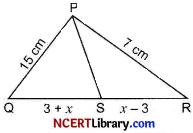
∴ \(\frac{P Q}{Q S}\) = \(\frac{P R}{S R}\)
⇒ \(\frac{15}{3+x}\) = \(\frac{7}{x-3}\)
⇒ 7(3 + x) = 15(x – 3)
⇒ 21 + 7x = 45 + 21
⇒ 15x – 7x = 45 + 21
⇒ 8x = 66
⇒ 4x = 33
⇒ x = 8.25 cm
![]()
Question 18.
Two circles touch each other externally at P. AB is a common tangent to the circles, touching them at A and B. The value of ∠APB is:
(a) 30°
(b) 45°
(c) 60°
(d) 90°
Answer:
(d) 90°
Explanation: Let PO meet AB at O such that PO is a tangent.
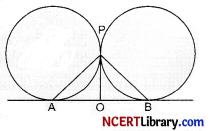
Thus, AO = PO = OB and ∠AOP = ∠BOP = 90°.
As △AOP and △BOP are right-angled isosceles triangles.
So, ∠OAP = ∠OPA = ∠OBP = ∠OPB = 45°
Thus, ∠APB = ∠APO + ∠OPB
= 45° + 45° = 90°
Question 19.
DIRECTION: In the question number 19 and 20, a statement of Assertion (A) is followed by a statement of Reason (R).
Choose the correct option
(a) Both assertion (A) and reason (R) are true and reason (R) is the correct explanation of assertion (A)
(b) Both assertion (A) and reason (R) are true and reason (R) is not the correct explanation of assertion (A)
(c) Assertion (A) is true but reason (R) is false.
(d) Assertion (A) is false but reason (R) is true.
Statement A (Assertion): ABC is an isosceles right triangle, right angled at C, then AB2 = 3AC2.
Statement R (Reason): In an isosceles triangle ABC, if AC = BC and AB2 = 2AC2, then ∠C = 90°.
Answer:
(d) Assertion is false but the Reason is true.
Explanation: For the assertion, by applying the Pythagoras theorem in the right angle triangle ABC, we get
AB2 = AC2 + BC2
= AC2 + AC2 [∵ BC = AC]
= 2AC2
So, the assertion is proved to be false.
For reason, by applying the Pythagoras theorem.
AB2 = 2AC2 = AC2
= AC2 + BC2
∴ ∠C = 90° (by converse of pythagoras theorem)
So, the given statement in the reason is true
Question 20.
Statement A (Assertion): If two tangent segments are drawn to one circle from the same external point, then they are congruent.
Statement R (Reason): If a line touches a circle, then perpendicular distance of the line from the centre of the circle is equal to the radius 20 of the circle.
Answer:
(b) Both the Assertion and the reason are correct but the reason is not the correct explanation of the assertion.
Explanation: As per the two-tangent theorem, if two tangent segments are drawn to one circle from the same external point, then they are congruent. So, the assertion is proved to be correct. For the reason, as per the tangent to a circle theorem ‘A line is tangent to a circle if and only if the line is perpendicular to the radius drawn to the point of tangency/ So, the statement in the reason is also true. But they don’t support or define each other.
Section – B
Question 21.
Explain why (17 × 5 × 11 × 3 × 2 + 2 × 11) is a composite number?
Answer:
17 × 5 × 11 × 3 × 2 + 2 × 11 = 17 × 5 × 3 × 22 + 22
= 22 (17 × 5 × 3 + 1)
= 22 (255 + 1)
= 2 × 11 × 256 …(i)
Now equation (i) is divisible by 2,11 and 256, which means it has more than 2 prime factors.
.’. (17 × 5 × 11 × 3 × 2 + 2 × 11) is a composite number.
Question 22.
Solve the quadratic equation \(x^2+2 \sqrt{2} x-6=0\)
OR
Solve the quadratic equation \(2 x^2+a x-a^2=0 \text { for } x\).
Answer:
Given quadratic equation is,
x2 + 2\(\sqrt{2} x\) – 6 =0
⇒ x2 + 3\(\sqrt{2} x\) – 2\(\sqrt{2} x\) – 6 =0
⇒ x(x + 3\(\sqrt{2} x\)) (x + 3\(\sqrt{2} x\)) = 0
⇒ (x + 3\(\sqrt{2} x\)) (x – \(\sqrt{2} x\)) = 0
⇒ x + 3\(\sqrt{2} x\) = 0 or x – \(\sqrt{2} x\) = 0
⇒ x = -3\(\sqrt{2} x\) or x = \(\sqrt{2} x\)
OR
Given quadratic equation is, 2x2 + ax – a2 =0
⇒ 2x2 + 2ax – ax – a2 =0
⇒ 2x (x + a) – a (x + a) = 0
⇒ (2x – a) (x + a) =0
⇒ x = \(\frac { a }{ 2 }\), x = -a
Question 23.
If the point P(m, 3) lies on the line segment joining the points \(\left(-\frac{2}{5}, 6\right)\) and B (2, 8), find the value of m.
Answer:
Given, A = \(\left(-\frac{2}{5}, 6\right)\) and B = (2,8) Also
P = (m,3) is on the line joining AB. Thus, A, B and P are collinear.
So, x1(y2 – y3) + x2(y3 – y1) + x3 (y1 – y2) = 0
Thus, –\(\frac { 2 }{ 5 }\) (8 – 3) + 2(3 – 6) + m (6 – 8) = 0
⇒ – 2 – 6 – 2m = 0
⇒ -2m = 8
⇒ m = -4.
Question 24.
Find the coordinates of point A, where AB is diameter of a circle whose centre is (2, – 3) and B is the point (1,4).
Answer:
Let the coordinates of point A be (x, y) and point O (2, – 3) be the centre, then
By mid-point formula, \(\frac{x+1}{2}\) = 2 and \(\frac{y+4}{2}\) = -3
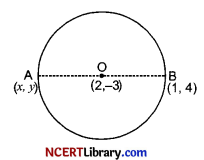
or x = 4 – 1 and y = – 6 – 4
⇒ x = 3 and y = – 10
∴ The co-ordinates of point A are (3, – 10)
Question 25.
Savita and Hamida are friends. What is the probability that both will have (i) same birthday, (ii) different birthdays (ignoring leap year)?
OR
A box contains cards numbered 11 to 123. A card is drawn at random from the box. Find the probability that the number on the drawn card is :
(i) a square number
(ii) a multiple of 8
Answer:
Savita may have any one of the 365 days of the year as her birthday. Similarly, Hamida may have any one of the 365 days of the year as her birthday.
Total number of ways in which Savita and Hamida may have their birthday = 365 × 365
(i) Savita and Hamida may have same birthday on any one of 365 days of the year.
∴ Number of ways in which Savita and Hamida will have birthday on same day = 365
Probability that Savita and Hamida will have birthday on same day = \(\frac{365}{365 \times 365}\) = \(\frac{1}{365}\).
(ii) Probability that Savita and Hamida will have different birthday
= 1 – Probability that Savita and Hamida will have birthday on same day
= 1 – \(\frac { 1 }{ 365 }\) = \(\frac { 364 }{ 365 }\)
OR
we have,
sample space = { 11, 12, 13, …, 123}
⇒ n(S) = 113
(i) Let E1 be the event that the card drawn is a square number.
So, E1 ={16,25,36, ….,121}
⇒ n( E1) = 8
∴ P(E1) = \(\frac { 8 }{ 113 }\)
(ii) ) Let E2 be the event that card drawn is a multiple of 8.
So, E2 = {16,24,32, ………, 120}
=> n(E2) = 14
∴ P(E2) = \(\frac { 14 }{ 113 }\)
Section – C
Question 26.
If a and P are the zeroes of the quadratic polynomial f(x) = x2 – p(x + 1) – c, then show that (β + 1)(α + 1) = 1 – c.
Answer:
Given : The quadratic polynomial is f(x) = x2 – p (x + 1) – c = x2 – px – (p + c) and α and β are the zeroes of the given polynomial.
We know that, Sum of the zeroes = –\(\frac { Coefficient of x }{ Coefficient of x2 }\)
Product of the zeroes = \(\frac { Coefficient term }{ Coefficient of x2 }\)
Therefore α + β = – \(\frac { (-p) }{ 1 }\)
α + β = p
and αβ = \(\frac{(-p-c)}{1}\)
αβ = – (p + c)
Now L.H.S. = (α + 1) (β + 1)
= αβ + (α + β) + 1
= -(p + c) + p + 1
= – p – c + p + 1
= – p – c + p + 1
= l – c
= R.H.S.
![]()
Question 27.
State whether the given pairs of triangles are similar or not. In case of similarity, mention the criterion.

OR
In the given figure, DEFG is a square and ∠BAC = 90°. prove that :
(i) △AGF ~ △DBG
(ii) △AGF ~ △EFC
(iii) △DBG ~ △EFC
(iv) DE2 = BD × EC.
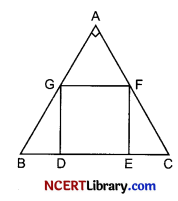
Answer:
(i) \(\frac { AO }{ DO }\) = \(\frac { 16 }{ 9 }\) and \(\frac { BO }{ CO }\) = \(\frac { 9 }{ 5 }\)
(ii) In △PQR, ∠P + ∠Q + ∠R = 180° [Angle-sum property of a △]
⇒ 45° + 78° + ∠R = 180°
⇒ ∠R = 180° – 45° – 78° = 57°
In △LMN, ∠L + ∠M + ∠N = 180° [Angle-sum property of a △]
⇒ 57° + 45° + ∠N = 180°
⇒ ∠N = 180° – 57° – 45° = 78°
Now, in △PQR and △LMN ∠P = ∠M [Each 45°]
∠Q = ∠N [Each 78°]
∠R = ∠L [Each 57°]
OR
(i) In △AGF and △DBG, we have
∠GAF = ∠BDG = 90°
and ∠AGF = ∠GBD [corresponding angles between parallel lines GF and BC with AB being the transversal as GDEF is a square]
Thus, by AA similarity criterion,
△AGF and △DBG.
(ii) In △AGF and △EFC, we have
∠GAF = ∠FEC = 90°
and ∠AFG =∠FCE [Corresponding angles between parallel lines GF and BC with AC being the transversal]
Thus, △AGF ~ △EFC
(iii) From (i) and (ii), we have
△AGF ~ △DBG
and △AGF ~ △EFC
Thus △DBG ~ △EFC
(iv) From (iii), we have
△DBG ~ △EFC
Thus, \(\frac{\mathrm{BD}}{\mathrm{FE}}\) = \(\frac{\mathrm{DG}}{\mathrm{EC}}\) [C.P.C.T.]
⇒ \(\frac{\mathrm{BD}}{\mathrm{DE}}\) = \(\frac{\mathrm{DE}}{\mathrm{EC}}\) [DE = DG = FE = GF as they are the sides of a square]
⇒ DE2 = BD × EC.
Question 28.
Prove that the parallelogram circumscribing a circle is a rhombus.
Answer:
Let ABCD be a parallelogram such that its sides touch a circle with centre O.
Now, we know that tangents to a circle from an exterior point are equal in length.
∴ AP = AS ….(i)
BP = BQ ….(ii)
CR = CQ ….(iii)
DR = DS …(iv)
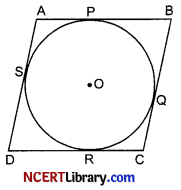
Adding equations (i), (ii), (iii) and (iv), we get
(AP + BP) + (CR + DR) = (AS + DS) + (BQ + CQ)
⇒ AB + CD = AD + BC
⇒ AB + AB = BC + BC
(Since ABCD is a parallelogram .’. AB = CD, BC = DA)
⇒ 2AB = 2BC
⇒ AB = BC
Thus, AB = BC = CD = AD
Hence, ABCD is a rhombus.
Question 29.
Prove that: 2 sec2 0 – sec4 0-2 cosec2 0 + cosec4 0 = cot4 0 – tan4 0.
OR
Prove that: \(\frac { cosec A }{ cosec A – 1 }\) + \(\frac { cosec A }{ cosec A + 1 }\) = 2 sec2 A
Answer:
L.H.S. = 2 sec2 θ – sec4 θ – 2 cosec2 θ + cosec4 θ
= 2 sec2 θ – (sec2 θ)2 – 2 cosec2 θ + (cosec2 θ)2
= 2(1 + tan2 θ) – (1 + tan2 θ)2 – 2(1 + cot2 θ) + (1 + cot2 θ)2
= 2 + 2 tan2 θ – 1 – tan4 θ – 2 tan2 θ – 2 – 2 cot2 θ + 1 + cot4 θ + 2cot2 θ
= cot4 θ – tan4 θ
= R.H.S.
OR
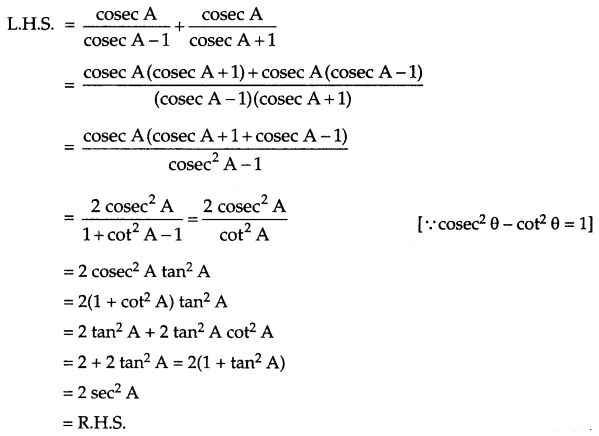
Question 30.
A two-digit number is such that the product of its digits is 20. If 9 is added to the number, the digit interchange their places. Find the number.
Answer:
Let the ten’s digit be x and the unit’s digit be y.
Thus, the given number is (10x + y) and its reverse is (10y + x).
So, xy = 20
⇒ x = \(\frac { 20 }{ y }\) …(i)
and 10x + y + 9 = 10y + x
⇒ 9x – 9y = – 9
⇒ x – y = – 1
⇒ \(\frac { 20 }{ y }\) – y = -1
⇒ 20 – y2 = -y
⇒ y2 – y – 20 = 0
⇒ y2 – 5y +4y – 20 = 0
⇒ y(y – 5) + 4(y – 5) = 0
⇒ (y – 5) (y + 4) = 0
⇒ y = 5, -4
So, x = \(\frac { 20 }{ 5 }\), – \(\frac { 20 }{ 4 }\)
⇒ x = 4, -5
Thus, the number is 45 or – 54.
![]()
Question 31.
The sum of the three numbers in A.P. is 21 and their product is 231. Find the numbers.
Answer:
Let the numbers be (a – d), a,(a + d).
So, the first term = a – d
and the common difference = d
We know, Sn = \(\frac { n }{ 2 }\) {2a + (n – 1)d}
⇒ S3 = \(\frac { 3 }{ 2 }\) {2(a – d) + (3 – 1)d}
⇒ 21 = \(\frac { 3 }{ 2 }\) {2a – 2d + 2d} [Given]
⇒ 3a = 21
⇒ a = 7
Now, (a – d) a(a + d) = 231
⇒ (7 – d) 7(7 + d) = 231 [Given]
⇒ 49 – d2 = 33
⇒ d2 = 16
⇒ d = ± 4
Thus, the numbers are either 3, 7, 11 or 11, 7, 3.
Section – D
Question 32.
Show that the sum of an AP whose first term is a, the second term b and the last term c, is equal to \(\frac{(a+c)(b+c-2 a)}{2(b-a)}\)
OR
The ratio of the 11th term to the 18th term of an AP is 2 : 3. Find the ratio of the 5th term to the 21st term and also the ratio of the sum of the first five terms to the sum of the first 21 terms.
Answer:
Given: a(first term) = a,
d = b – a,an = c
By the formula of nth term, a + (n – 1)d = c
(n – 1)(b – a) = c – a
(n – 1) = \(\frac { c – a }{ b – a }\)
n = \(\frac { (c – a) }{ (b – a) }\) + 1
= \(\frac{c-a+b-a}{b-a}\)
n = \(\frac{b + c – 2 a}{b – a}\)
Now, find the sum of n terms.
Sn = \(\frac { n }{ 2 }\) [2a + (n – 1) D]
= \(\frac{(b+c-2 a)}{2(b-a)}\) \(\left[2 a+\left\{\frac{b+c-2 a}{b-a}-1\right\}(b-a)\right]\)
= \(\frac{(b+c-2 a)}{2(b-a)}\) \(\left[2 a+\left\{\frac{b+c-2 a-b+a}{b-a}\right\}(b-a)\right]\)
= \(\frac{(b+c-2 a)}{2(b-a)}\) [2a + c – a]
= \(\frac{(b+c-2 a)}{2(b-a)}\) (a + c)
OR
Let a be the first term and d be the common difference of an AP.
a11 : a18 = 2 : 3
⇒ \(\frac{a+10 d}{a+17 d}\) = \(\frac { 2 }{ 3 }\)
⇒ 3a + 30d = 2a + 34d
⇒ 3a – 2a = 34d – 30d
⇒ a = 4d ….(i)
To find: \(\frac{a_5}{a_{21}}\) = \(\frac{a+4 d}{a+20 d}\) = \(\frac{4 d+4 d}{4 d+20 d}\)
= \(\frac{8 d}{24 d}\) = \(\frac { 1 }{ 3 }\)
Now, the ratio of a5 : a21 = 1 : 3
Now, teh ratio of sum \(\frac{\mathrm{S}_5}{\mathrm{~S}_{21}}\) = \(\frac{\frac{5}{2}[2 a+(5-1) d]}{\frac{21}{2}[2 a+(21-1) d]}\)
⇒ \(\frac{\mathrm{S}_5}{\mathrm{~S}_{21}}\) = \(\frac{5}{21}\)\(\frac{[2 a+4 d]}{[2 a+20 d]}\)
= \(\frac{5}{21}\) \(\frac{[2(4 d)+4 d]}{[2(4 d)+20 d]}\)
= \(\frac{5}{21}\) \(\frac{[8 d+4 d]}{[8 d+20 d]}\)
= \(\frac{5 \times 12 d}{21 \times 28 d}\)
= \(\frac{5}{7 \times 7}\) = \(\frac{5}{49}\) = 5 : 49
Hence, S5 : S21 = 5 : 49.
Question 33.
Prove that the opposite sides of a quadrilateral circumscribing a circle subtend supplementary angles at the centre of the circle.
Answer:
Given, a circle with centre O touches the opposite sides of a quadrilateral at points P, Q, R and S.
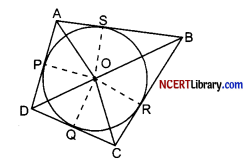
In order to prove the above, the following need to be satisfied :
∠AOB + ∠COD = 180° and ∠AOD + ∠BOC = 180°
Join OS, OP, OQ and OR.
In AOQC and AOCR,
QC = CR [Tangents from external point C]
OC =OC [common]
OQ = OR [Radii of circle]
Thus △OQC ≅ △ORC [by s.s.s. congruency]
Hence ∠QOC = ∠COR [Corresponding angles of congruent triangles]
Similarly, ∠ROB = ∠SOB, ∠SOA = ∠POA
and ∠POD = ∠QOD
Now ∠QOC + ∠COR + ∠ROB + ∠SOB + ∠SOA + ∠POA + ∠POD + ∠QOD = 360° (∵ O is point)
⇒ 2(∠QOC + ∠ROB + ∠SOA + ∠POD) = 360°
and 2(∠COR + ∠SOB + ∠POA + ∠QOD = 360°
⇒ ∠QOC + ∠ROB + ∠SOA + ∠POD = 180°
and ∠COR + ∠SOB + ∠POA + ∠QOD = 180°
⇒ ∠QOC + ∠SOB + ∠SOA + ∠QOD = 180°
and ∠COR + ∠ROB + ∠POA + ∠POD = 180°
⇒ ∠QOC + ∠QOD + ∠SOA + ∠QOD = 180°
and ∠COR + ∠ROB + ∠POA + ∠POD = 180°
⇒ ∠AOB + ∠COD = 180°
and ∠AOD + ∠BOC = 180°
Question 34.
If sec θ + tan θ = p, show that: \(\frac{p^2-1}{p^2+1}\) = sin θ.
Answer:
Given: sec θ + tan θ = p
Now, L.H.S. = \(\frac{p^2-1}{p^2+1}\)
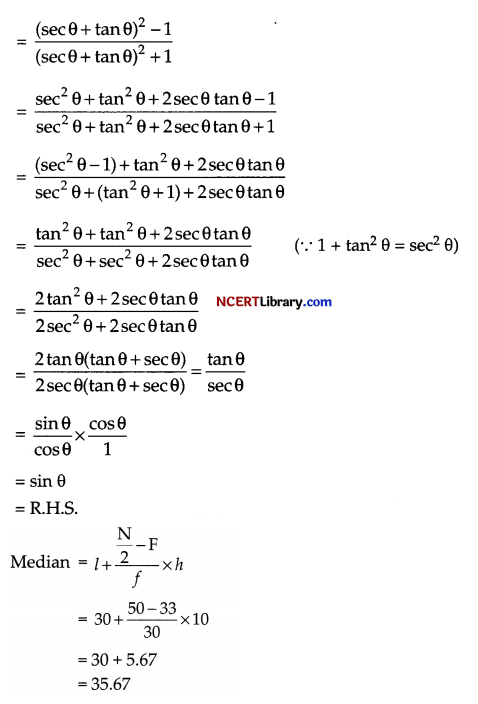
We know, Mode = 3 Median – 2 Mean
⇒ Mode = 3(35.67) – 2(35.6)
= 107.01 – 71.2
= 35.81
OR
As this series is an inclusive one, we can make it exclusive by adding 0.5 to the upper limit and subtracting 0.5 from the lower limit of each class interval. Thus, we have
| Class Interval | Frequency (fi) | Mid value (xi) | ui = \(\frac{x_i-\mathbf{A}}{h}\); | fi × ui |
| 24.5-29.5 | 14 | 27 | h = upper limit – lower limit | 42 |
| 29.5-34.5 | 22 | 32 | -3 | 44 |
| 34.5-39.5 | 16 | 37 | -2 | 16 |
| 39.5-44.5 | 6 | 42 = A | -1 | 0 |
| 44.5-49.5 | 5 | 47 | 0 | 5 |
| 49.5-54.5 | 3 | 52 | 1 | 6 |
| 54.5-59.5 | 4 | 57 | 2 | 12 |
| Σfi=70 | Σ (fi × ui) = – 79 |
Thus, A = 42, h = 5, Σfi = 70, Σ(fi × ui) = – 79
Mean, = A + \(\left\{h \times \frac{\Sigma\left(f_i \times u_i\right)}{\Sigma f_i}\right\}\)
= 42 + \(\left\{5 \times \frac{(-79)}{70}\right\}\)
= 42 – 5.64
= 36.36.
Section – E
Question 36.
Sun casts a shadow on a nearby tree and building. If the height of building is √3 times the length of shadow and the angle of elevation of the top of building from its tip of shadow which is 160 m away from building is 60°. Based on the given data and answer the following questions :
(i) What is the angle of elevation of sun from tree?
(ii) What is the height of building?
(iii) If another building 80 m high casts a shadow of length 120 m. Find the angle of elevation.
OR
If the length of the shadow reduces from 160 m to 80 m and height of building remains same. Calculate the angle of depression of shadow tip from the top of building.
Answer:
(i) Given, height of building = √3 times × length of shadow (l)
h = √3 (l)
So, tan θ = \(\frac{\sqrt{3} l}{l}\)
or tan θ = √3
∴ θ = 60° ( ∵ tan 60° = √3)
(ii) Here, tan 60° = \(\frac{Height of building (h)}{Length of the shadow}\)
√3 = \(\frac{ h }{ 160 }\)
So, h = 160 √3 m
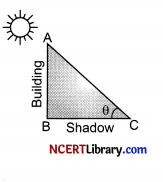
(iii) Here tan θ = \(\frac{Height of building }{Length of the shadow}\)
⇒ tan θ = \(\frac{80 m }{ 120 m }\)
⇒ tan θ = \(\frac{ 2 }{ 3 }\)
or θ = tan-1 \(\left(\frac{2}{3}\right)\).
OR
Here tan θ = \(\frac{Height of building }{Length of the shadow}\)
⇒ tan θ = \(\frac{160 \sqrt{3} \mathrm{~m}}{80 \mathrm{~m}}\)
∵ θ = tan-1 (2√3)
![]()
Question 37.
A company wants to make frames as part of a new product that they are launching. This frame is rectangular in shape, and cut out of a sheet of steel. In this frame a smaller rectangle will be cut out from the bigger sheet of steel, so as to lower down its weight.
The inner dimensions of the steel frame are 6 cm × 11 cm and the width of the frame is ‘x’ cm. The final area of the frame is 28 cm2.
Answer the following questions:
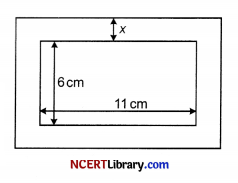
(i) What is the dimensions of outer frame in terms of ‘x’l
(ii) Form a quadratic equation in terms of x, if the final area of the frame is 28 cm2.
(iii) What is the value of ‘k’r if the given equation (9x2 + 6kx + 4 = 0) has equal roots?
OR
What is the width of the frame?
Answer:
(i) Length of outer frame = (11 + 2x) cm
Breadth of outer frame = (6 + 2x) cm
(ii) Here, Area of frame = Area of outer rectangle – Area of inner rectangle
= (6 + 2x) (11 + 2x) – 6 × 11
= 66 + 22x + 12x + 4x2 – 66
= 34x + 4x2
⇒ 34x + 4x2 = 28
⇒ 4x2 + 17x – 14 = 0
(iii) Here, 9x2 + 6kx + 4 = 0
For equal roots, D = b2 – 4ac = 0
⇒ 36 = k2 – 144 = 0
⇒ k2 = 4
⇒ k = ± 2
OR
on the basis of equation obtained in part (ii), we get
2x2 + 17x – 14 = 0
∴ x = \(\frac{-b \pm \sqrt{b^2-4 a c}}{2 a}\) = \(\frac{-17 \pm \sqrt{289+112}}{2 \times 2}\)
= \(\frac{-17 \pm \sqrt{401}}{4}\) = \(\frac{-17 \pm 20.02}{4}\)
= 0.8 or – 9.3
≈ 1 cm
Question 38.
Sita and Savita had 2 cubes of same dimension. They want to join the cubes as show in the figure.

The resulting shape is a cuboid. The side of the cube is 8 cm.
Answer the following question:
(i) What are the dimensions of the resulting cuboid?
(ii) If the resulting cuboid, needs to be covered by a paper, how much area of paper is needed?
(iii) What is the volume of the resulting cuboid?
OR
If the cost of the paper is ₹ 0.05/cm2. What is the total cost of the paper pasted on the cuboid?
Answer:
(i) In resulting cuboid, length gets doubled, breadth and height remains same
Then l = 8 + 8 = 16 cm
b = 8 cm, h = 8 cm Ans.
(ii) Total surface area of cuboid = 2 (lb + bh + hi)
= 2(16 × 8 + 8 × 8 × 16 × 8)
= 2 (128 + 64 + 122)
= 2 × 320 = 640 cm2
(iii) Dimension of cuboid = 16 cm, 8 cm, 8 cm
Volume of cuboid = lbh
= 16 × 8 × 8
= 1024 cm3
OR
T.S.A. of paper used = 640 cm2
Rate of paper = ₹ 0.05/cm2
∴ Cost of paper = ₹ 640 × 0.05
= \(\frac{640 \times 5}{100}\) = ₹ 32